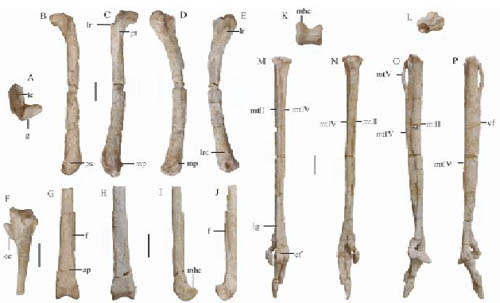Specimen From China-Canada Dinosaur Expedition Re-identified a New Troodontid
The 1988 China-Canada dinosaur expedition to Bayan Mandahu, Wulatehouqi (Urat Rear Banner), Nei Mongol (Inner Mongolia) produced many Late Cretaceous vertebrate fossils. Among them, a small, partial theropod hindlimb with an interesting combination of morphological features, catalogued as IVPP (Institute of Vertebrate Paleontology and Paleoanthropology, Beijing) V 10597, was assigned to the troodontid Saurornithoides mongoliensis by Currie and Peng (1994). Dr. XU Xing, Institute of Vertebrate Paleontology and Paleoanthropology (IVPP), Chinese Academy of Sciences, and his team re-examined the morphology of V 10597, and found it is actually a new troodontid, Philovenator curriei gen. et sp. nov., as reported in the latest issue of Vertebrata PalAsiatica 2012(2). This new find increases the known taxonomic diversity and morphological disparity of Late Cretaceous troodontids.
Based on several lines of evidence: the general morphology of V 10597 is very similar to that of previously known Late Cretaceous troodontid hindlimbs; among previously known taxa, Saurornithoides mongoliensis most closely resembles V 10597 in hindlimb morphology; and the Bayan Mandahu fauna was then considered to be identical to the Djadokhta fauna from which Saurornithoides mongoliensis was recovered, Currie and Peng described it as a juvenile Saurornithoides mongoliensis in 1994, and attributed some significant differences between V 10597 and other troodontids and much smaller size than the hindlimbs of the other troodontids that were known at the time to ontogenetic variation.
“The recent discovery of the Bayan Mandahu troodontid Linhevenator tani raised the possibility that V 10597 might actually represent a juvenile individual of this species, given that V 10597 is more similar to Linhevenator than to Saurornithoides”, said XU Xing, “After re-examination of the morphology of V 10597, as well as an investigation of its histology, we were finally able to describe systematically and ontogenetically significant features preserved in V 10597, and reconsider the taxonomy of this specimen for our better understanding of troodontid evolution”.
Specimen V 10597 differs significantly from other troodontids, including L. tani, in numerous hindlimb features and particularly in the proportions of various hindlimb elements. Furthermore, histological analysis indicates that V 10597 is unlikely to be a juvenile of L. tani or any other large troodontid. Based on the available morphological and histological information, XU Xing and his team proposed the erection of a new taxon, Philovenator curriei gen. et sp. nov., based on V 10597.
Although represented by limited material, Philovenator curriei is significant in that it increases not only the known taxonomic diversity, but also the morphological disparity, of Late Cretaceous troodontid dinosaurs. Most obviously, P. curriei is much smaller than most other Late Cretaceous troodontids. This indicates significant size disparity among Late Cretaceous troodontids, resembling the situation in some other coelurosaurian groups such as the Dromaeosauridae. Furthermore, the hindlimbs, particularly the pes, of P. curriei are extremely specialized, as indicated by the proportionally extremely long, transversely slender, and anteroposteriorly deep tarsometatarsus. The new find indicates that morphological disparity among Late Cretaceous troodontids is greater than previously known.
This project was supported by the National Natural Science Foundation of China and the Department of Land and Resources, Nei Mongol, China. 
Fig.1 Photographs of IVPP V 10597, left femur in proximal (A), anterior (B), posterior (C), medial (D) and lateral (E) views; proximal portion of left tibiotarsus in lateral view (F); distal portion of left tibiotarsus in anterior (G), posterior (H), medial (I), lateral (J) and distal (K) views; left pes in proximal (L), anterior (M), posterior (N), medial (O), and lateral (P) views. Scale bars = 1 cm. (Image by XU Xing)
Download attachments: